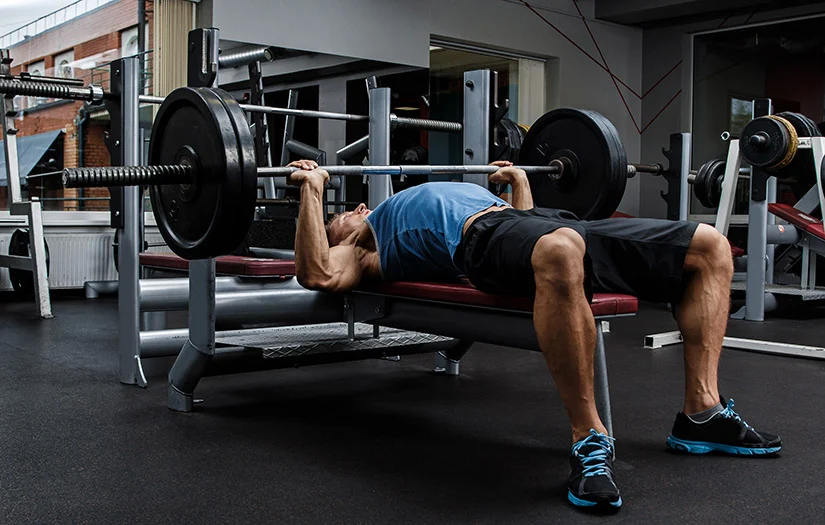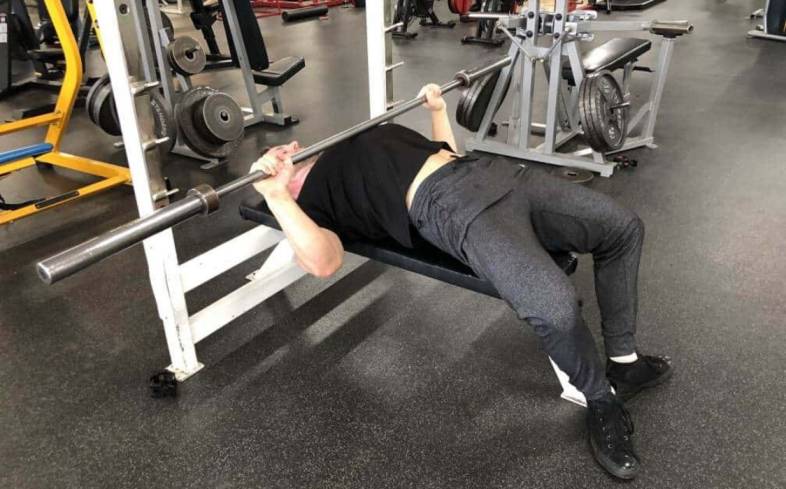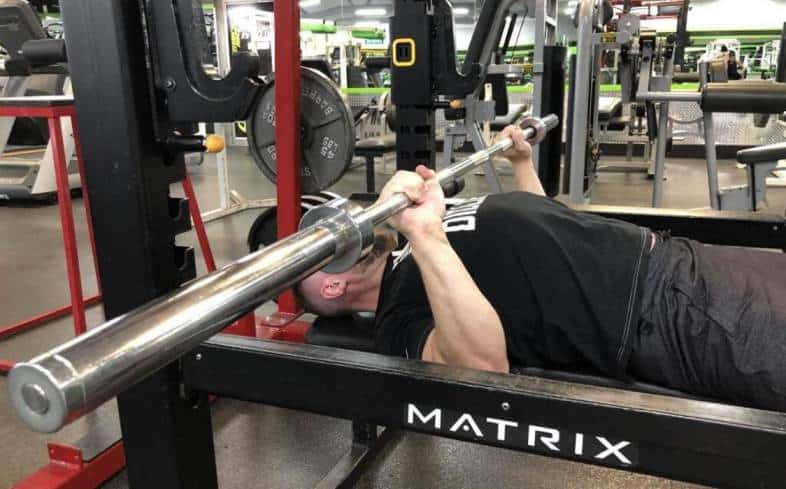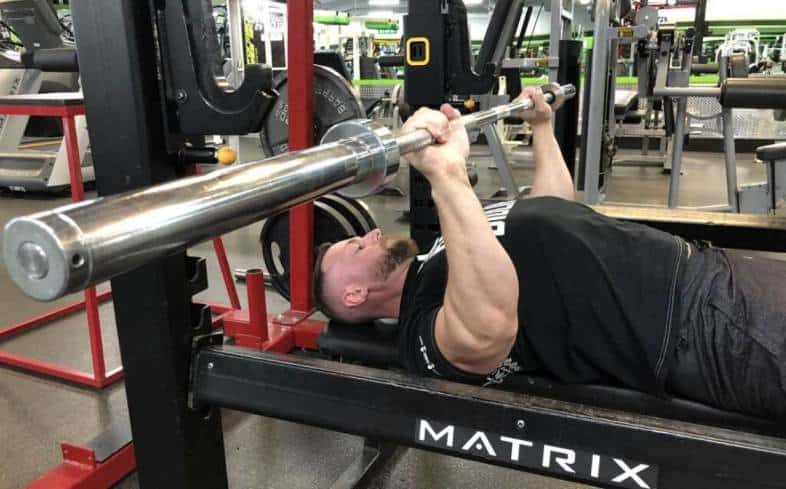Should Powerlifters Do Incline Bench Press? (It Depends) | PowerliftingTechnique.com (original) (raw)
There are no shortages of bench press accessories that a powerlifter can implement into their training program.
One of the deciding factors when selecting your bench press accessories should be whether or not they help increase your bench press strength overall. In other words, if you do an incline bench will it improve your numbers in the competition (flat) bench press?
So, should powerlifters do incline bench press? Powerlifters should do incline bench press if they have a shoulder and upper pec weakness that prevents them from getting stronger in the competition bench press. This is because the anterior delt and upper pec muscles are activated to a larger extend in the incline vs flat bench press.
The incline bench can be an important exercise as a powerlifter if you fit certain criteria. In this article, we'll cover those criteria, and recommend other exercises that might help you get stronger in the bench press overall. Let's get started!
Check out my guide on 9 Highly Effective Bench Press Alternatives
Muscles Used: Incline vs Flat Bench Press

Incline Bench Press
In order to understand whether the incline bench press has carryover to the bench press, we’ll need to look at the muscles involved in each movement.
If you have a muscular weakness in the bench press that the incline bench press can develop more effectively, then you’ll have a greater carryover effect to the bench press.
As a powerlifter, selecting the right exercises that have the biggest impact for improving overall strength is your utmost priority. Your bench press accessories should not be selected randomly.
Muscles Used In The Bench Press
If you're interested in a more in-depth guide on the anatomy and biomechanics, check out my complete guide on the Muscles Used For The Bench Press. It will cover how muscle activation changes based on grip width, bench angle, and range of motion.
With that said, here are the quick points that you need to understand:
- The prime muscle groups in the bench press are the pecs, shoulders, and triceps
- In the bottom range, when the bar is on your chest, the pecs are most activated
- In the mid-range, the front of the shoulders (anterior deltoids) are most activated
- In the top-range, when the weight is near lock-out, the triceps are most activated
- The wider you grip the barbell, the more the pecs are activated.
- The narrower you grip the barbell, the more the triceps are activated
- Regardless of your grip, your shoulders seem to be equally as active.
- The lower your touch-point is on your chest, the more your shoulders will be activated
This article won't cover how to select the most optimal grip or touch-point for bench press. But I encourage you to read my other articles on Bench Press Grip and Bench Pressing With Long Arms.
Muscles Used In The Incline Bench Press
The incline bench press uses the same muscle groups as the flat bench press, but significantly increases activation in certain areas:
- The incline bench activates the upper pecs more than the flat and decline variations.
- A 45-degree bench incline has the most activation in the upper pecs compared with other angles.
- The higher the incline of the bench, the higher the anterior deltoid activation (55+ degrees).
- During the incline bench, tricep activation is reduced by 50% when compared with flat and decline variations.
The incline bench press is an excellent way to target the chest muscles if you can't feel your pecs while bench pressing.
How This Information Helps You?
The important takeaway should be that the incline bench press will use far greater upper pec and shoulder strength than the flat bench press.
So if your competition (flat) bench press is being held back because of an upper pec and shoulder weakness, then performing the incline bench press can help break through plateaus in your strength.
The key thing to know now is how to determine whether you have an upper pec and shoulder weakness. This is what we'll cover next.
Read more about 17 Exercises That Will Improve Your Bench Press Strength.

Want to improve your bench press technique?
Where Is Your Sticking Point In The Bench Press
Now that you know what muscles are responsible for each movement, you’ll want to identify where your sticking point is in the bench press. If the muscles responsible for your sticking point can be developed using the incline bench press, then it might be an effective strategy for getting stronger.
Failing In The Bottom Range

If you fail the bench press in the bottom range of motion, this means that your pec muscles are the weak link.
We know that the upper pec muscles are activated to a larger extend in the incline bench press. So, if you fail in the bottom range of the bench press will incline bench help your overall bench strength?
It depends on two factors: (1) the bench press arch and (2) touchpoint.
Take a look at my article on Is The Incline Bench Press Harder?
1. Bench Press Arch
You need to look at whether you use a bench press arch or not.
For lifters that have a large bench press arch, it's been shown that the fibers of the lower pec are used more in the bottom range of motion versus the upper pec.
However, if you bench press with a relatively flat back, either because you haven't learned how to arch properly, or you lack the mobility needed, then your upper pec muscles will be an important contributor to driving the bar off your chest.
If that's the case, then the incline bench press will have a decent carryover to bringing up your competition (flat) bench press numbers.
2. Touchpoint
Remember I said that your anterior delts are more activated if you touch lower on your chest?
Therefore, you need to analyze where you're touching the bar on your chest. If the touchpoint is at or below your sternum, and you're failing under heavy weights in the bottom range of motion, then this is a good indication that you might have a shoulder weakness.
As such, you'll get more benefit from doing an incline bench press because you'll develop the required shoulder strength necessary to drive the bar up from your lower touchpoint.
Check out my complete guide on the bench press touchpoint, which will depend on your grip and arm length.
Failing In The Mid Range

If you fail in the mid-range of the bench press, this means that your anterior delts are the weak link.
As previously mentioned, the anterior delts have greater activation during the incline bench press, especially when the bench angle is at or above 55-degrees.
So, if you’re failing in the mid-range, the incline bench press would be a good exercise in building up the strength required to overcome your sticking point.
In fact, if this is the case, I would go one step further and suggest that you prioritize the incline bench press over all other bench press accessories for a significant amount of time (8-12 weeks).
If you're failing in the mid-range of the bench press, you'll want to check out my guide on Does Overhead Press Help Bench Press?
The incline bench press was named as one of my top dumbbell chest fly alternatives.
Failing In The Top Range

If you fail in the top-range of the bench press, this means that your triceps are the weak link.
While the incline bench and flat bench both use the triceps to extend the elbow, I don’t believe that the incline bench would be the best exercise to develop lock-out strength.
If you want to develop a stronger lock-out, check out my articles on the 16 Best Tricep Exercises To Increase Bench Press Strength and 9 Proven Ways To Develop a Stronger Bench Press Lock-Out. .
All of this to say, I would not implement incline bench press if you have a tricep weakness. It would only have marginal carryover to the bench press and you would have more effectiveness choosing another exercise.
The incline bench press was included in my article on the Best Bench Press Variations. Check it out for more exercises to include in your bench press programming.
How To Implement Incline Bench Press Into Your Powerlifting Program
So if you've decided that the incline bench press (vs. decline bench press) would be a good way to improve the strength of your overall flat bench pres for powerlifting, then how should you implement it into your training program?
There are 5 things to consider:
1. Specificity
You'll want to be careful of simply substituting the incline bench press with your competition (flat) bench press.
If you want to get stronger in the bench press, you’ll need to maintain a high level of specificity in that movement.
This idea of ‘specificity’ simply means that in order to adapt positively the stimulus needs to be specific to the outcome.
In other words, if you want to get stronger in the bench press, you still need to focus on progressively overloading the bench press more than any other exercise. This brings me to my next point: training frequency.
2. Training Frequency
Training frequency refers to how many times per week you perform a specific movement.
If you only flat bench 1X per week, I would be concerned if you replaced this workout with an incline bench because of the lack of specificity. Therefore, this would be a good time to increase your frequency to 2X/week and have one session being flat bench and the other being an incline bench.
If you currently bench press 2X per week, I would incorporate the incline bench on one of those workouts, either substituting the incline for the flat bench on that day or performing it following the flat bench as a secondary movement.
If you currently bench press 3X per week, you have the option of doing incline bench press either 1-2 days/week out of the three total sessions. From my experience though, you can make significant progress in the incline bench by implementing it once per week.
If you're interested in learning about bench press frequency, then read my article on How Many Times Per Week Should You Bench Press?.
3. Periodization
Peridiozation refers to the systematic long-term approach you take with your programming.
There are several periodization models; however, a simple block periodization approach will work just fine with your incline bench press.
I would set up the training cycles to look like the following:
- Block #1 (4-6 weeks): Prioritizing hypertrophy adaptations to build muscle mass and linearly increasing the volume week to week using a moderate rep range (6-10) and average intensities (60-75% of 1 rep max).
- Block #2 (4-6 weeks): Prioritizing neural adaptations to build strength and linearly increasing the load week to week using a low rep range (2-5) and high intensities (80-90% of 1 rep max).
- Block #3: (2-4 weeks): Start to transition to focusing on flat bench press versus incline bench press to see whether the increase in upper pec and shoulder strength made an impact.
4. Other Exercises
If you need to bring up the strength of your upper pecs and anterior delts, you also need to think about your exercise selection more holistically.
While the incline bench press can make a meaningful impact on the strength of your flat bench, there are likely other exercises that you should be doing, including:
- Wide Grip Bench Press (3-4 fingers wider than normal using a flat back, i.e no arch)
- Overhead Barbell Shoulder Press
- Seated Dumbbell Arnold Press
- Incline Dumbbell Pec Flys
- Lateral Dumbbell Raises
Related Article: The Ultimate List Of 55+ Barbell Exercises (By Muscle Group)
Final Thoughts
As a powerlifter, implementing the incline bench press should be a factor of whether or not you think the exercise will have a carryover to your competition (flat) bench press. If you have a weakness in the bottom-end or mid-range of the bench press, then the incline bench may be an exercise that helps improve your overall strength.